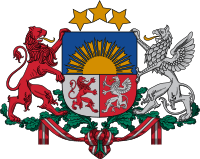Coat of arms of Latvia
| Coat of arms of Latvia | |
|---|---|

|
|
| Versions | |
 Extended small national coat of arms |
|
 Small national coat of arms |
|
| Details |
The coat of arms of Latvia was designed by Rihards Zariņš after the proclamation of the Republic of Latvia ( November 18, 1918 ) and addresses the national sovereignty of Latvia.
description
The coat of arms combines symbols of a Latvian nation-state with symbols that represent the historical regions.
Blazon
Description of coat of arms : Latvia has a divided coat of arms , split at the bottom . The coat of arms is blue above, in it a rising golden sun with twenty-one alternately broadening rays, split below; in front on silver a left-turned red lion with a golden tongue, behind on red a right-turned silver weapon-wielding griffin with a golden tongue. An arch of three five-pointed gold stars rests on the shield . This is the so-called "small coat of arms".
meaning
The national independence of Latvia is represented by the golden sun rising on a blue background in the coat of arms : A sun symbol was the symbol of recognition and identification of the Latvian riflemen in the Russian army in the First World War . At that time the sun was still represented with 17 rays, which symbolized the 17 Latvian districts of that time. In 1935 the number of Latvian counties had risen to 18. Nowadays the sun is represented with 21 rays. A reference to the 26 existing districts today can no longer be established.
The three gold stars above the coat of arms represent the union of the three historical landscape areas - Courland (including Zemgallia ), Livonia and Latgale - in a unified Latvia.
These landscape areas are represented in the coat of arms below by the heraldic figures from the 16th century :
- Courland and Zemgale are symbolized by the red lion on silver. The lion appears in the coat of arms of the former Duchy of Courland as early as 1569.
- Livonia and Latgale are symbolized by the silver griffin on red. This symbol dates from 1566, when the present-day territory of Livonia and Latgale was under Polish-Lithuanian rule.
Use of coat of arms
The use of the national coat of arms of Latvia is prescribed by the Saeima .
Large national coat of arms
The large national coat of arms differs from the small national coat of arms by the two coat of arms holders . On the right a red lion with a golden tongue and on the left the silver griffin with a golden tongue, standing on two green oak branches, which are connected by a ribbon in the colors of the Latvian flag.
The great national coat of arms of Latvia is used by:
- the president
- the Saeima , its commissions and members
- the Cabinet of Ministers
- Ministries and selected ministers of Latvia
- the State Control
- the constitutional court
- the Supreme Court
- the attorney general
- the office of the protection of the constitution
- the Bank of Latvia ( Latvijas Banka , the Latvian Central Bank)
- the diplomatic missions and consular bodies of Latvia
Extended small national coat of arms
The extended small national coat of arms differs from the small national coat of arms by the additional two green oak leaf branches, which cross below the coat of arms shield and rise up to the height of the rising sun.
The Extended Small State Coat of Arms is used by:
- the Saeima Chancellery, the Presidential Chancellery and the State Chancellery
- the Saeima members, certain institutions or officials
- the Cabinet of Ministers and other institutions subordinate to the ministries
- the ministries, the State Control, the Supreme Court, the General Prosecutor's Office and the institutions of the Latvian Central Bank
- the regional courts, district or city courts and the land registry offices at the regional courts
- the registry offices
- the facilities of the public prosecutor's office
- the sworn notaries
- the election commissions
Small national coat of arms
The Small State Coat of Arms ( see picture above ) is used by:
- the other state institutions
- the municipal councils
- the state educational institutions on official documents
literature
- Karl-Heinz Hesmer: Flags and coats of arms of the world. History and symbolism of the flags and coats of arms of all states . Gütersloh: Bertelsmann Lexikon Verlag, 1992. ISBN 3-570-01082-1
Web links
- Flag lexicon (description of flag and coat of arms)
- The Latvian Institute on the national coat of arms ( English )
- Decree of the Saeima on the use of the coat of arms ( Latvian )